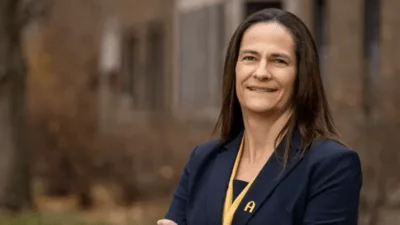Quad City Arts recently issued the following announcement.
Just as last year was unusual for the Quad City Arts Metro Arts Youth Apprenticeship Program, the summer of 2020 also was unique.
Far fewer students – ages 15 to 21 – participated in fewer projects, and they wore face coverings and practiced social distancing. That does not mean that the two outdoor murals and improvisational comedy they created were any less meaningful, important or impressive.
“Every Metro Arts site has a collection of masks available, if the student either doesn’t have one or has forgotten theirs that day, so we can make sure we’re following the social-distancing guidelines and keeping everybody safe,” Quad City Arts executive director Kevin Maynard said, noting the lead artists also wore masks.
“I don’t think that our social distancing guidelines have hindered the process or progress on any of these projects,” he said. “It has limited the number of apprentices. Most sites typically have 10 apprentices and a lead artist, but with the (Illinois) guidelines in phase 3 being no groups larger than 10, we did have to cut an apprentice from each project.”
Compared to 2019, when there were about 90 apprentices doing projects throughout the Quad-Cities in the spring, summer and fall, this year about 30 area youth were provided with five-week paid summer apprenticeships.
These apprentices create projects that positively impact our community: a mural in Moline, improv comedy, and a mural in Rock Island. These projects were made possible through support from the City of Rock Island, Friendship Manor, Modern Woodmen of America, The Moline Foundation, and Renew Moline.
Since summer 2000, Metro Arts has provided youth ages 15-21 with paid summer apprenticeships in various arts disciplines. They work together in groups to complete projects that enhance the community through the arts. Participants learn artistic techniques and applications of their genre while developing personally and professionally.
This program allows young adults to develop new career and artistic skills, build self-confidence and creates a sense of accomplishment as they work under the supervision and mentorship of professional artists. Their mentors are accomplished, local artists who are passionate about teaching and encouraging creativity.
The first Metro Arts in 2000 was modeled after the successful arts-education and job-training program Gallery 37 in Chicago, which launched in 1991 with a concept that spread to cities across the nation.
Metro Arts 2000 was headed by visual artist and project coordinator Lori Roderick. A former artist-in-residence at Quad City Arts, she supervised a professional faculty of five, along with 69 students from 21 area high schools that year. Students (who then were paid $5.50 an hour) had to list two references, but didn't need to have any previous job experience, and there were no artistic criteria.
That first year (like in 2020), the projects included improvisational comedy and painted murals.
It also included a ceramic tile mural and show choir, and subsequent years the dazzlingly diverse program has featured more murals, poetry, dance, jazz, playwriting, sculpture, creative writing, voice, mosaics, graphic novel, percussion, micro-fiction, graphic design, mixed media, and photography.
Since the beginning, Metro Arts has served 1,140 students and produced 96 varied projects.
“This year, we obviously knew it would be a lot smaller – there were no spring projects with the pandemic going on,” said lead artist Sarah Robb of Davenport, who led both new murals, at 1516 6th Ave., Moline, and on three sides of the Friendship Manor maintenance building, at Rock Island’s 11th Street and 21st Avenue.
In her 14th summer leading Metro Arts, she worked with eight young artists daily in Moline in the morning for four hours and nine in Rock Island in the afternoon.
If painting close together, the students were required to wear masks or face shields, and unlike previous years, did not share paint or buckets with water to rinse brushes. Masks were provided in case students forget to bring one, as well as hand sanitizer, water and sunscreen.
A classy, colorful landscape
The mural in Moline is in the courtyard on 6th Avenue next to La Primavera, on the wall of Bajas Classy Resale, a women’s clothing store across the street from the mural Robb led in 2018 for the Child Abuse Council (which was supported in part by Quad City Arts’ Arts Dollars, but wasn’t a Metro Arts project).
The new mural (called “It’s a New Day”) is the first Metro Arts project in the city of Moline, supported by Renew Moline and The Moline Foundation. Specifically, The Tom and Karen Getz Memorial Fund was established at The Moline Foundation to support and promote civic pride, youth development and the arts. Tom and Karen served and led innumerable community organizations with energy, commitment, and heart.
“It has a positive message during this time – hopeful, a lot of color,” Robb said. The students at both locations have been “troupers” and seamlessly adjusted to the circumstances. The Moline mural will have a ribbon-cutting Friday morning.
“Once they’re working, they’re in their own world,” Robb said. “We just look different because we have masks on. They all get it, have been cooperative and thankful they still have the opportunity.”
“The best part is the community of other artists, and we get to know their style and connect it to make one piece,” said senior Moline apprentice Rebecca Quick, a 21-year-old Moline High alum who attends Monmouth College. “We’re sweating like crazy, but keeping our distance and we’re making it work.”
“There have been a lot of changes due to the virus, but obviously things aren’t that different,” said Kamryn Linskey, a 2020 Sherrard High grad who last year did Metro Arts at the MLK Center in Rock Island. “It’s definitely the same amount of fun as last year. Working with Sarah, it’s been awesome.”
Since Friendship Manor is a larger project, which involved nearby Olivet Baptist Church, Robb took a break and started another five weeks in late July with a new group of a dozen apprentices to finish the building.
“That was by design, because it is such a large project, we split it up into essentially groups and two projects,” Maynard said, noting stipends for the apprentices are $500 each; $750 for the senior apprentice, and $2,000 for lead artists.
“Most of the cost for the mural goes into the labor and materials. We do have a small administration fee, which is around 9 percent of the total cost. We typically ask building owners to come up with some of those funds,” he said, noting they typically pay at least $4,000 and an average mural costs around $10,000, based on size and number of apprentices.
In 2018, Robb led the painting of the Child Abuse Council wall facing 6th Avenue in downtown Moline between 15th and 16th streets and a new mural for Moline’s Floreciente neighborhood at 8th Street and 6th Avenue.
The CAC mural caught the attention of Pam Fisher, who owns the Bajas building, which led to the creation to that new mural. Robb in 2018 also helped a friend and fellow muralist, Heidi Sallows, paint the wall outside Fred & Ethel’s antique store at a new Rock Island pocket park at 30th Street and 14th Avenue.
She first partnered with Sallows in 2010 on the huge sea-themed wall of Cabanas at 2120 4th Ave., Rock Island. The two led several 2019 Metro Arts murals throughout the Q-C, including at the Quad City Symphony office at 4th and Brady streets, Davenport, and street murals throughout Bettendorf.
Bringing the funny outdoors
This summer’s three-student improv comedy group met daily at Schwiebert Park in Rock Island and was led by Erin Mahr, a Rocky grad who did improv with Metro Arts in 2002.
“So it’s fun to be on the other side now,” she said. “At the time, I didn’t think I’d ever teach it. I had so much fun learning improv games at the time, and I thought it was a great opportunity to earn money while learning a fun skill like improv. I enjoyed ComedySportz, learning the different games and skills there.”
Mahr was in ComedySportz from 2010 until last year, when it disbanded, and is a performer with G.I.T. Improv.
This year, with students masked, “It’s been an interesting year,” she said. Mahr was co-lead artist last year with Patrick Adamson, at Rock Island’s former Establishment Theatre, now owned by the Center for Living Arts. They’re outside this year, partly to be safer health-wise.
“In improv, you have to work more with body language, being able to hear and understand each other,” Mahr said. “The apprentices have done a wonderful job of adapting and making the most of their experience, given the situation.”
Improv comedy translates to everyday life skills, she said. “It’s great for public speaking; it’s a great confidence builder, even just social skills.”
“What I enjoy most about the improv program is the fact that I get to do something I love every day, and I also get to make new friends that otherwise wouldn’t have existed,” said Teddi White, 18, a new Bettendorf High grad in her second year of Metro Arts. “It’s a little difficult working with masks for a few reasons. It gets very hot very quickly, it’s harder to enunciate, and it’s harder to tell other’s facial expressions.”
“I love improv because it’s really flexible and free,” she said, noting she first did improv about eight years ago in a class at Davenport Junior Theatre and has been to multiple ComedySportz shows.
A virtual showcase
Covid also forced changes in how Metro Arts presented its annual showcase – virtually this year, which was on July 9 (on Facebook and the Quad City Arts YouTube channel).
“In a typical year, we’d have every apprentice in the same room, on stage, with their friends and family, talking about the projects they’ve completed and showing some pictures,” Maynard said. “That’s not an option this year, so we’re bringing 3-4 people from each group to talk about their project. We would bring on everybody, but we are limited in how many we can have in the program we use, at one time.”
Original source can be found here.





 Alerts Sign-up
Alerts Sign-up